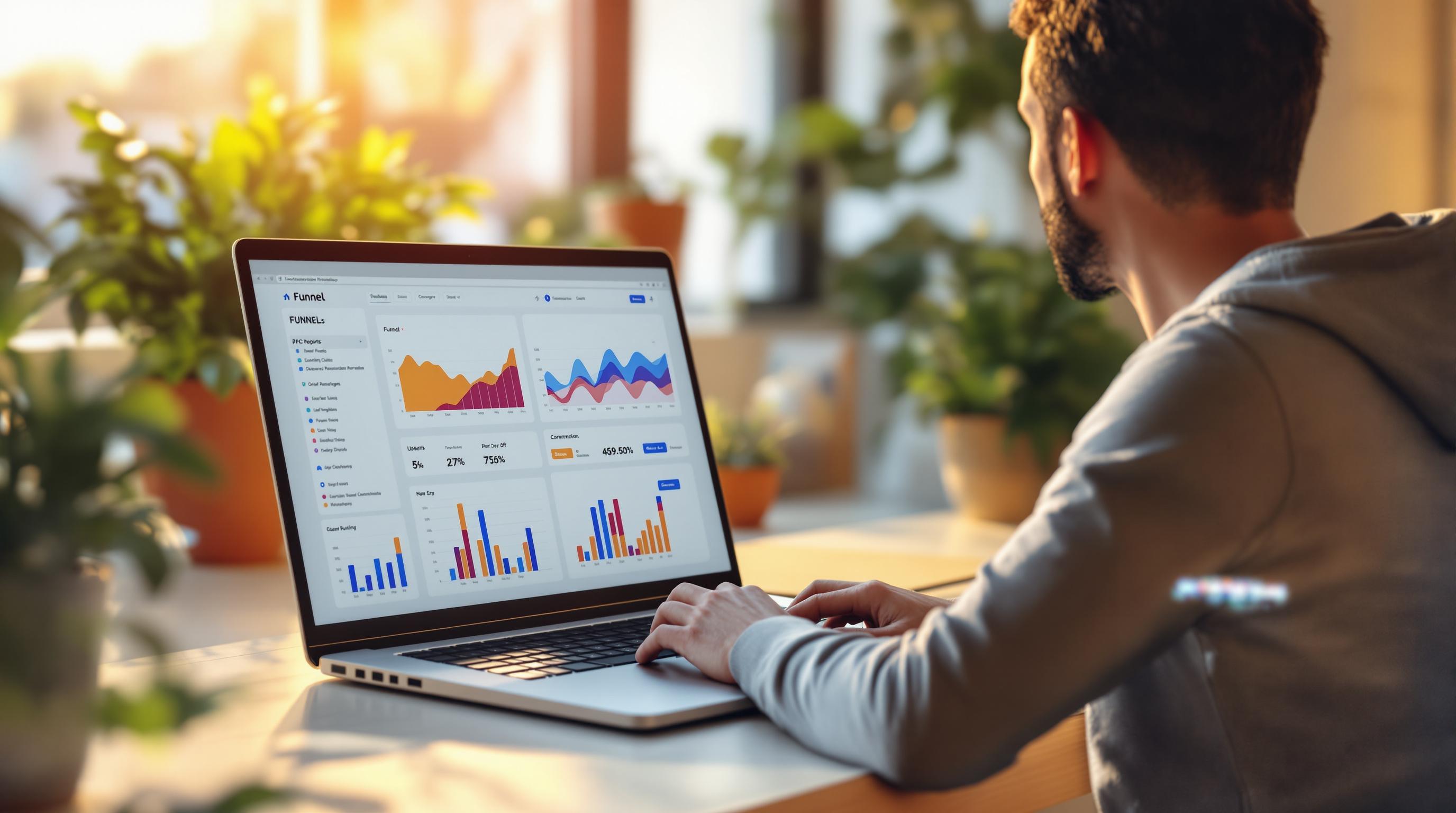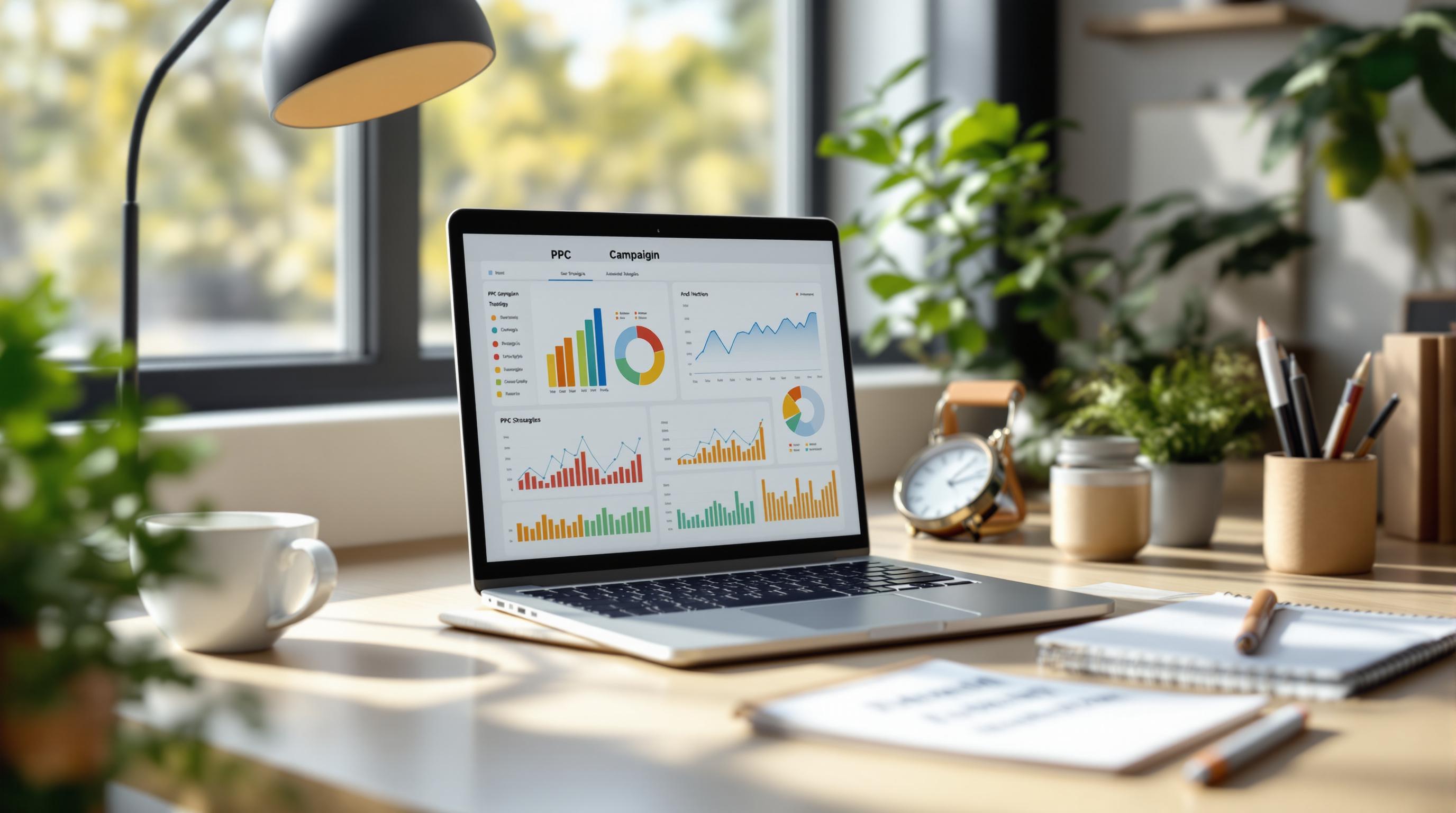When deciding how to manage your PPC campaigns, the choice between manual bidding and automated bidding depends on your goals, budget, and resources.
- Manual Bidding: Gives you full control over keyword bids, allowing precise adjustments. Best for small campaigns, niche markets, or when you need to oversee every detail. However, it requires time, expertise, and constant monitoring.
- Automated Bidding: Uses algorithms to adjust bids in real-time based on data like user behavior and performance trends. Ideal for large-scale campaigns with historical data and limited time for manual adjustments. Setup is simpler, but it takes time to optimize and reduces direct control.
Quick Comparison
| Feature | Manual Bidding | Automated Bidding |
|---|---|---|
| Control | Full control over bids | Limited control, algorithm-driven |
| Time Investment | High, requires ongoing management | Low after initial setup |
| Data Requirements | Works with limited data | Needs strong historical data |
| Best For | Small/niche campaigns | Large-scale campaigns |
| Performance | Relies on expertise for results | Real-time adjustments by algorithm |
Choose manual bidding if you value precision and control. Opt for automated bidding to save time and scale efficiently. Both strategies can deliver strong results when aligned with your campaign goals.
Manual CPC vs. Automated Bidding: Which is Right for Your New Google Ads Campaign?
Manual Bidding Explained
Manual bidding is all about giving advertisers full control over their pay-per-click (PPC) campaigns. It allows you to set specific bid amounts for keywords and ad groups, tailoring your strategy to meet your goals.
How Does Manual Bidding Work?
With manual bidding, you decide how much you're willing to pay for each click. This means you set maximum bid amounts for individual keywords or ad groups. To make the most of this approach, you'll need to keep an eye on key metrics like CTR (click-through rate), conversion rates, and CPA (cost per acquisition). Regular adjustments based on performance data are essential to keep your campaigns on track.
"Manual bidding requires continuous monitoring and adjustment of bids to optimize performance" [1].
Advantages and Disadvantages of Manual Bidding
When it comes to manual bidding, there are clear pros and cons to weigh:
| Aspect | Advantages | Disadvantages |
|---|---|---|
| Control | Full control over bids and targeting | Potential for human error |
| Flexibility | Quick adjustments to strategy | Can be time-intensive |
| Customization | Tailored targeting for niche markets | Requires significant resources |
| Expertise | Deeper insights into campaign performance | Needs strong PPC knowledge |
This approach works particularly well in industries where understanding customer behavior and market trends is crucial [5]. If you have the expertise, time, and a clear understanding of your audience, manual bidding can deliver great results.
To get the most out of manual bidding, focus on high-value keywords and track performance metrics closely. This allows you to maintain control while running an efficient campaign.
While manual bidding gives you precision and control, automated bidding offers a more hands-off alternative for managing PPC campaigns.
Automated Bidding Overview
What is Automated Bidding?
Automated bidding relies on algorithms to evaluate performance data and adjust bids in real-time to meet your campaign objectives. It’s a great option for advertisers looking to streamline their PPC efforts and scale effectively. This method takes into account various factors like past performance, user behavior, device type, location, and even seasonal trends to fine-tune bids.
Common Automated Bidding Strategies
Google's Smart Bidding offers several strategies designed for different advertising goals:
| Strategy | Primary Goal | Best For |
|---|---|---|
| Target CPA | Keep cost per acquisition consistent | Lead generation |
| Target ROAS | Hit a specific return on ad spend | E-commerce |
| Maximize Conversions | Maximize conversions within budget | Brand awareness |
| Enhanced CPC | Combine manual control with automation | Testing campaigns |
Pros and Cons of Automated Bidding
| Aspect | Benefits | Limitations |
|---|---|---|
| Time Management | Saves time on manual adjustments | Requires careful setup initially |
| Data Processing | Quickly analyzes large data sets | Needs a solid amount of historical data |
| Performance | Adjusts bids in real-time | May take time to fully optimize |
| Control | Handles complex calculations efficiently | Reduces direct control over bids |
If you’re aiming to get the most out of automated bidding, platforms like the Top PPC Marketing Directory can help you choose and fine-tune the right strategy for your campaign goals.
Now that you understand automated bidding, it’s worth diving into how it stacks up against manual bidding to find the best fit for your needs.
sbb-itb-89b8f36
Comparing Manual and Automated Bidding
Control and Flexibility
Manual bidding lets you fine-tune your campaigns with precise adjustments, putting you in full control. On the other hand, automated bidding uses algorithms to make decisions based on data. According to SEMrush, automated bidding can lower cost per conversion by 22% compared to manual methods [2][4].
Time and Effort Needed
The amount of time and effort each approach demands can shape your campaign strategy significantly.
| Aspect | Manual Bidding | Automated Bidding |
|---|---|---|
| Setup and Learning Curve | Requires detailed technical skills and continuous learning | Focuses on setup with basic platform understanding |
| Optimization and Analysis | Needs frequent monitoring and manual changes | Handles optimization automatically using data |
| Time Investment | Requires ongoing, hands-on management | Limited time needed after setup |
Performance and Data Usage
Automated bidding shines when it comes to processing large volumes of data, such as user behavior and seasonal trends, to make real-time adjustments. For instance, one retailer switched to automated bidding and experienced a 30% boost in sales while cutting CPA by 18% [2][4].
"For the vast majority of folks, automated bid strategies give the best bang for the buck." - Rival Digital [1]
Keep in mind, automated bidding typically needs a 4-8 week learning phase to reach peak efficiency. During this time, it’s best to avoid making big changes so the algorithm can collect enough data [2][3].
How to Choose the Right Bidding Strategy
Key Factors to Evaluate
The right bidding strategy depends on your goals, budget, and available resources. Whether you're aiming to boost conversions, improve visibility, or manage costs, your approach should align with your campaign's objectives.
| Factor | Manual Bidding Consideration | Automated Bidding Consideration |
|---|---|---|
| Budget Size | Works well for smaller, tightly controlled budgets | Suited for larger, more flexible budgets |
| Data Volume | Effective with limited data | Performs best with a strong history of data |
| Team Resources | Requires time and expertise | Needs minimal ongoing management |
| Campaign Scale | Ideal for small to medium campaigns | Best for managing large-scale campaigns |
When Manual Bidding is a Good Choice
Manual bidding is ideal when you need full control over your bids. It’s particularly useful for niche markets or specialized campaigns where human judgment plays a key role.
Consider manual bidding if:
- You want precise control over individual keyword bids.
- You have insights that automated systems might overlook.
- Your campaign is new and lacks historical data.
- You're working in a specialized or highly regulated industry.
When Automated Bidding is a Better Option
Automated bidding works best for larger campaigns with plenty of data. Ian Dawson, Search Engine Marketing Manager at HawkSEM, emphasizes that well-chosen bid strategies are essential for improving campaign performance and driving results [9]. This approach works well when:
- Your campaign has a solid base of historical data.
- You're managing multiple ad groups or keywords at once.
- You need to optimize for complex conversion patterns.
- Your team has limited time for manual adjustments.
Using automation can help streamline processes and focus your efforts on strategy rather than constant manual fine-tuning.
Using the Top PPC Marketing Directory
To make the most of your chosen strategy, the Top PPC Marketing Directory offers tools and resources for both manual and automated bidding. This platform helps you find the right solutions to execute your campaigns efficiently and achieve your goals.
Conclusion
Choosing between manual and automated bidding strategies can greatly impact the success of your PPC campaigns. By understanding the differences, you can tailor your approach to meet your campaign's specific needs.
Key Takeaways
When it comes to Smart Bidding, conversion volume and value often outweigh budget considerations. This insight helps advertisers decide on the best strategy for their campaigns, regardless of how much they plan to spend.
Here are some important factors to keep in mind:
- Data Needs: Manual bidding is ideal for campaigns with limited data, while automated bidding generally requires at least 50 conversions over 30 days to perform well.
- Level of Control: Manual bidding gives you full control and requires active management, whereas automated bidding relies on algorithms to optimize performance.
- Time and Expertise: Manual bidding demands more time and skill, while automated bidding involves less ongoing effort.
- Performance Potential: Both methods can deliver strong results if applied and managed correctly.
Whether you opt for manual bidding in niche markets or automated bidding for larger-scale campaigns, success depends on setting clear goals and keeping a close eye on performance. Platforms like the Top PPC Marketing Directory can also help you find the right tools and resources to fine-tune your strategy. Always align your approach with your objectives and adjust as needed.


